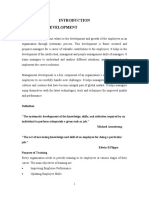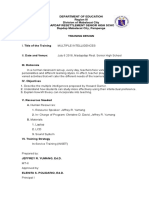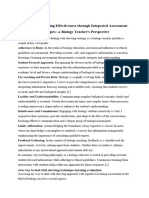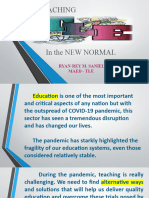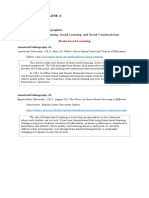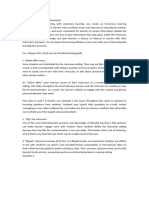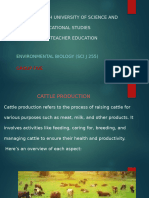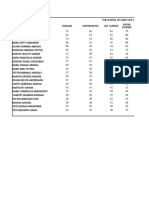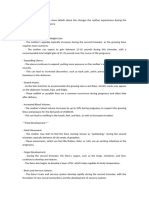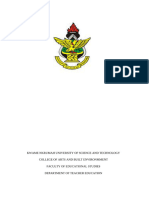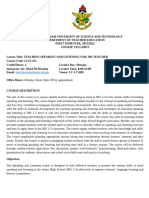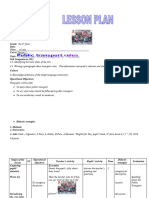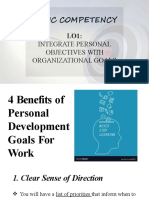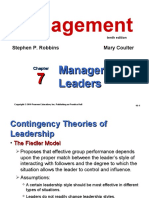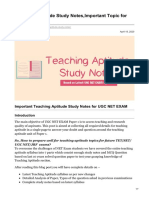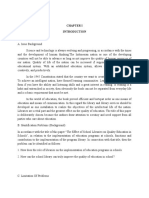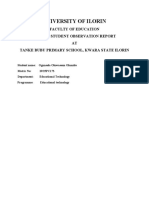Biology Teaching Styles.
Biology Teaching Styles.
Uploaded by
ankamahinstagramCopyright:
Available Formats
Biology Teaching Styles.
Biology Teaching Styles.
Uploaded by
ankamahinstagramCopyright
Available Formats
Share this document
Did you find this document useful?
Is this content inappropriate?
Copyright:
Available Formats
Biology Teaching Styles.
Biology Teaching Styles.
Uploaded by
ankamahinstagramCopyright:
Available Formats
Biology Teaching Styles
1.) Relate Biology to Everyday Life
Biology topics relate to beauty, healthcare, clothing, fuel, and more. Biology permeates so many
aspects of everyday life, so these examples are used to teach. Start by tapping into your students’
natural curiosity of life, making biology relevant to them by relating topics taught in the
classroom with their everyday lives. This form of integrative learning has many benefits,
including improved student learning retention and creative thinking.
2.) Do Interesting Experiments
A biology lesson can be a hands-on experience. Doing interesting experiments can engage
students and help them get excited about their learning. Students can extract DNA from fruit like
a banana or strawberry, dissect a frog, or examine a fingerprint. Utilize anything that gets their
brains going and helps them learn the material. This method is commonly thought of as a hands
on and minds on approach to teach science where students have the opportunity to gain some
experience with phenomena associated with their course of study. In this method either students
participate alone or in small groups. They produce or manipulate various variables that are under
exploration. The degree to which a student has control over exploration can vary over a wide
range. Here the students learn by actual doing rather than my observing the experiments. As
young children do it by themselves, the experience is impressed more firmly in their minds.
Thus, this method is psychologically sound as it satisfies the natural urge for activity. This
method broadens the interest of the students. They learn many virtues through laboratory activity.
The experience in a laboratory is very rich in personal satisfaction as they gain it firsthand. The
sense of excitement and challenge help them to achieve something tangible.
3.) Variety in teaching
One of the keyways to engage students in any subject is by alternating between teaching styles so
that the classroom doesn’t become predictable and stagnant. It’s useful to remember that students
learn in all different ways, so alternating teaching styles regularly not only keeps them more
engaged but allows some students more opportunities to learn in accordance with their learning
style. A recent survey found that 22.8% of respondents prefer kinaesthetic learning, making it
the most popular learning style and beating auditory, visual and read/write by an impressive
margin.
By offering a range of materials such as textbooks, podcasts, videos and games, this will enable
different kinds of learners to absorb the greatest amount of information from them. In addition,
there are various methods to help students learn a topic including lecturing, concept mapping,
discussions, reading and allowing for cooperative student learning or assigning practical
activities.
4.Biology Field Trips
Hosting biology-centered field trips provides a change of pace from the traditional classroom and
can bring about a host of benefits that encourage student engagement and learning. Having
practical biology in action can reinforce the lessons taught in class and cement them in your
students’ minds. Consider visiting a local park, wilderness reserve, farm or botanical garden to
allow students to see, in person, the topics they were learning about. Similarly, a trip to a science
museum or research lab can open pupils’ eyes to the vast progress humans have made in science,
highlighting life-saving Inventions from the past or current innovations.
5.Incorporate technology
Students interact with technology on a daily basis and are therefore comfortable and open to
being taught through this medium. Technology, and the array of information on the internet, can
be utilized in the classroom to innovatively teach biology. Technology can engage all different
kinds of students as it caters to a variety of learning styles including auditory, visual and
kinesthetic. There are many educational resources available online that can be utilized both in the
planning and execution of teaching biology.
6.Project Method
This method was propounded by W.H Kilpatrick. This method was perfected by J.A Sternson.
The base of this method lies in the philosophy of pragmatism. This method emphasizes building
a comprehensive unit around an activity which may be carried out in school or outside. The
essence of this method lies in the fact that a group of students do a purposeful task. This implies
the students undertake the activity in a group or individually over a period of time. It may
include a few activities and the product is in the form of written report or a display. “A project is
a whole-hearted purposeful activity proceeding in a social environment”- Dr. William Kilpatrick.
“A project is a problematic act carried to completion in its natural setting”. – Stevenson. “A
project is a bit of real life that has been imported into school. – Ballard. Thus, a project is a
purposeful activity and planned activity which is achieved in social, natural situations created in
schools.
. Problem Solving Method
Science subject is one of the important subjects in school education. However, really the
traditional teaching methods are challenged for their inability to foster critical thinking, holistic
learning environment among children. The science subject must develop science process skills
where children, observe, measure, classify, process information, interpret think on solving
problems, analyze, synthesize, formulate conclusions, etc. but, it should be kept in mind that,
creativity in an essential element of P.S. In a problem-solving method, children learn by working
on problems. This enables the students to learn new knowledge by facing the problems to be
solved. The students are expected to observe, understand, analyze, interpret, find solutions,
perform applications that lead to a holistic understanding of the concept. This method develops
scientific process skills. This method helps in developing a brainstorming approach to learning
concepts. The students thinking on problem and their understanding of the science behind it is
based on common sense. It does not start from textual knowledge. Rather it proceeds from
experiencing to gradually forming concepts through books at a later stage. It is a process from
practice to theory not vice versa. Knowledge here is not a goal but a natural outcome of working
on tasks. Students live in the real world and like to deal with concrete things where they can
touch, feel manipulate things then the method is useful in igniting the process of science
learning.
You might also like
- Model Course 1.39 Leadership & TeamworkDocument50 pagesModel Course 1.39 Leadership & Teamworkyobi juan90% (10)
- Lesson Plan in Reading and Writing SkillsDocument6 pagesLesson Plan in Reading and Writing SkillsAvimar Faminiano Fronda III100% (3)
- TRAINING AND DEVELOPMENT AT Mahindra & MahindraDocument6 pagesTRAINING AND DEVELOPMENT AT Mahindra & MahindraUpadhayayAnkurNo ratings yet
- 700.4P For Literacy Lesson Plan. Part 2.editedDocument5 pages700.4P For Literacy Lesson Plan. Part 2.editedPINTOONo ratings yet
- Ecd 303 Methods of Teaching Science and Maths NotesDocument36 pagesEcd 303 Methods of Teaching Science and Maths NotesLydiah kinyaNo ratings yet
- 10 Innovative Learning Strategies For Modern PedagogyDocument5 pages10 Innovative Learning Strategies For Modern PedagogyAlfie Ventura Bugayong100% (1)
- Slac ReportDocument6 pagesSlac Reportjeffrey yumangNo ratings yet
- Shepherdville College: Sci. Teaching Science in The Primary Grades (Bilogy & Chemistry)Document10 pagesShepherdville College: Sci. Teaching Science in The Primary Grades (Bilogy & Chemistry)Margie AbanesNo ratings yet
- DocumentDocument12 pagesDocumentLaarnie Blessful SucalNo ratings yet
- Learning Through InquiryDocument8 pagesLearning Through Inquiryaman jyotiNo ratings yet
- Chapter 5 Science LiteracyDocument11 pagesChapter 5 Science LiteracyJulius MacaballugNo ratings yet
- Learning Through InquiryDocument9 pagesLearning Through InquiryAatif IlyasNo ratings yet
- Learning Through Inquiry PDFDocument9 pagesLearning Through Inquiry PDFĐồng Thị NgaNo ratings yet
- Chapter 4-Reflection 4 - CABALIDADocument5 pagesChapter 4-Reflection 4 - CABALIDAJeralyn CABALIDANo ratings yet
- Module 1Document4 pagesModule 1Allen Mae ColoniaNo ratings yet
- Science EducationDocument7 pagesScience EducationRyan Ceazar AguilaNo ratings yet
- Pedagogical Innovations in School Educat PDFDocument18 pagesPedagogical Innovations in School Educat PDFTaniyaNo ratings yet
- Thesis Chapter 1Document10 pagesThesis Chapter 1Maria Camille Villanueva SantiagoNo ratings yet
- Effective Teaching Strategies in ScienceDocument4 pagesEffective Teaching Strategies in ScienceJayson LeoncioNo ratings yet
- The Impact of Integrating Inquiry-Based Learning Approach in Teaching Science, Technology, and Society Education On StudentsDocument14 pagesThe Impact of Integrating Inquiry-Based Learning Approach in Teaching Science, Technology, and Society Education On Studentscruzmaerose3No ratings yet
- DokumenDocument9 pagesDokumenBaiq IrmaNo ratings yet
- Inquiry Guided FinalDocument16 pagesInquiry Guided FinalJazzel Queny Zaldua100% (1)
- Modern TeachingDocument4 pagesModern TeachingashpattiNo ratings yet
- Lab Arts ExamDocument4 pagesLab Arts ExamPhil LajomNo ratings yet
- AssignmentDocument9 pagesAssignmentsharveyishwarNo ratings yet
- What Is ScienceDocument5 pagesWhat Is Scienceliezelconsigna03No ratings yet
- OBSERVATIONEXPERIMENTATIONDocument28 pagesOBSERVATIONEXPERIMENTATIONMyrna MañiboNo ratings yet
- Learning Pedagogy: Facilitator Dr. Munish KhannaDocument16 pagesLearning Pedagogy: Facilitator Dr. Munish KhannaParul KhannaNo ratings yet
- Lesson 1: SC - Sci 1 - Teaching Science in The Elementary GradesDocument44 pagesLesson 1: SC - Sci 1 - Teaching Science in The Elementary GradesAnika Gabrielle SeNo ratings yet
- Barboza Bryan m5 Activity 1 2ced 3Document20 pagesBarboza Bryan m5 Activity 1 2ced 3Trisha Anne BataraNo ratings yet
- Lord 1998Document10 pagesLord 1998api-329324684No ratings yet
- Educ 5312Document7 pagesEduc 5312api-668204861No ratings yet
- Mulicultural Final PaperDocument6 pagesMulicultural Final Paperapi-636843021No ratings yet
- Sci-101-Activity 2Document2 pagesSci-101-Activity 2Joycelen Mae Tejero SantaNo ratings yet
- Week 7 Group 8 Section 4Document3 pagesWeek 7 Group 8 Section 4Chareynel Ayuban RadañaNo ratings yet
- ScienceDocument38 pagesScienceapi-272545554No ratings yet
- Activity 1 Objectives of Science EducationDocument2 pagesActivity 1 Objectives of Science EducationYu ErinNo ratings yet
- LAC Nov. 18,2022 Strategies and Technique in Teaching ScienceDocument31 pagesLAC Nov. 18,2022 Strategies and Technique in Teaching ScienceCharm Vergara100% (1)
- Students On The Ecosystem Material (Research Conducted at SMAN 1 Cariu, Bogor) - ThisDocument3 pagesStudents On The Ecosystem Material (Research Conducted at SMAN 1 Cariu, Bogor) - ThisAdhe Suhe NotsueNo ratings yet
- Active Learning in The Science ClassroomDocument33 pagesActive Learning in The Science Classroomatharva.borole2011No ratings yet
- Ilocos Sur Polytechnic State CollegeDocument4 pagesIlocos Sur Polytechnic State Collegecharo bao-ilanNo ratings yet
- Research Inquiry Teaching ApproachDocument25 pagesResearch Inquiry Teaching ApproachAfni ZulkiflyNo ratings yet
- Chapter IDocument9 pagesChapter IClare AlcoberNo ratings yet
- Modes of TransactionDocument179 pagesModes of Transactionmadhulika440No ratings yet
- Teaching Science in Elementary GradesDocument21 pagesTeaching Science in Elementary GradesMa Paula Jean BrezuelaNo ratings yet
- 10 Innovative Learning Strategies For Modern PedagogyDocument4 pages10 Innovative Learning Strategies For Modern Pedagogynelly sinagaNo ratings yet
- Lesson # 1 Introduction To SCIENCEDocument5 pagesLesson # 1 Introduction To SCIENCEZhayna CaleonNo ratings yet
- York Report FinalOct2010Document32 pagesYork Report FinalOct2010mohd azriNo ratings yet
- Modern Teaching MethodsDocument11 pagesModern Teaching MethodsHijab BatoolNo ratings yet
- EED9Document25 pagesEED9andrea.babonNo ratings yet
- Unit 3Document9 pagesUnit 3Anoshia ZamanNo ratings yet
- Written Report: Approaches, Methods, Techniques, and Strategies in Teaching SciencesDocument6 pagesWritten Report: Approaches, Methods, Techniques, and Strategies in Teaching SciencesRUTHY ANN BALBIN BEEd 2-1No ratings yet
- Annotated BibliographyDocument6 pagesAnnotated Bibliographytannerolson3486No ratings yet
- Teaching StrategiesDocument10 pagesTeaching StrategiesLes ChiensNo ratings yet
- Gelli Module EducDocument8 pagesGelli Module EducGellirose S. BantayanNo ratings yet
- Teach 1 AnalysisDocument8 pagesTeach 1 AnalysisNick BiancoNo ratings yet
- Teaching TLE in The New NormalDocument27 pagesTeaching TLE in The New NormalKRISTINE ANNE MENDOZANo ratings yet
- Lumanog, Ronalyn L. BEE EGE 2-1worksheet 1-Module 2Document2 pagesLumanog, Ronalyn L. BEE EGE 2-1worksheet 1-Module 2Ronalyn LumanogNo ratings yet
- Revised Az Final PaperDocument24 pagesRevised Az Final Paperapi-705616526No ratings yet
- Proposal For Study NEWDocument19 pagesProposal For Study NEWAfni ZulkiflyNo ratings yet
- Lozada Assignment - Science Is impo-WPS OfficeDocument4 pagesLozada Assignment - Science Is impo-WPS OfficeRosemarie banogNo ratings yet
- Final Exam Q1 PDFDocument5 pagesFinal Exam Q1 PDFLEE ZIWEINo ratings yet
- Anotated Bibliographies For Brain-Based Learning, Social Learning and Social ConstructivismDocument7 pagesAnotated Bibliographies For Brain-Based Learning, Social Learning and Social ConstructivismCharlene BelmonteNo ratings yet
- MAED Social Studies Adv. PedagogyDocument13 pagesMAED Social Studies Adv. PedagogyRochelenDeTorresNo ratings yet
- The Project Approach in Early Years Provision: A practical guide to promoting children's creativity and critical thinking through project workFrom EverandThe Project Approach in Early Years Provision: A practical guide to promoting children's creativity and critical thinking through project workRating: 5 out of 5 stars5/5 (2)
- 19 When The Books Are Balanced - Etmfj Vol 6 - Power Point OpenDocument86 pages19 When The Books Are Balanced - Etmfj Vol 6 - Power Point OpenankamahinstagramNo ratings yet
- An Immersive LeDocument1 pageAn Immersive LeankamahinstagramNo ratings yet
- BIOLOGY GROUP FIVE (5) Animal HusbandryDocument14 pagesBIOLOGY GROUP FIVE (5) Animal HusbandryankamahinstagramNo ratings yet
- 02 Use It or Lose It-ETMFJ3 (WORD TEXT GUIDE)Document14 pages02 Use It or Lose It-ETMFJ3 (WORD TEXT GUIDE)ankamahinstagramNo ratings yet
- C 2Document1 pageC 2ankamahinstagramNo ratings yet
- NansenDocument1 pageNansenankamahinstagramNo ratings yet
- Cover LetterDocument2 pagesCover LetterankamahinstagramNo ratings yet
- Scholar ReusltsDocument3 pagesScholar ReusltsankamahinstagramNo ratings yet
- Amaning Owusu Junior SRJDocument21 pagesAmaning Owusu Junior SRJankamahinstagramNo ratings yet
- Changes in Mother Second TrimesterDocument2 pagesChanges in Mother Second TrimesterankamahinstagramNo ratings yet
- Copy-Front Page Stanley XXDocument39 pagesCopy-Front Page Stanley XXankamahinstagramNo ratings yet
- Course OutlineDocument3 pagesCourse OutlineankamahinstagramNo ratings yet
- Cl.6 U.6L.2 The Public Transport RulesDocument5 pagesCl.6 U.6L.2 The Public Transport RulesAlina CebotariNo ratings yet
- Module 4 - Developing Self Discipline and SkillsDocument6 pagesModule 4 - Developing Self Discipline and SkillsKARENETTE TANNo ratings yet
- Basic LO1 - Integrate Personal Objectives With Organizational GoalsDocument17 pagesBasic LO1 - Integrate Personal Objectives With Organizational GoalsHenzel SabileNo ratings yet
- Management: Managers As LeadersDocument7 pagesManagement: Managers As LeadersAhmedNo ratings yet
- Unit 3 What Day Is It Today ?: LESSON ONE (4,5,6)Document2 pagesUnit 3 What Day Is It Today ?: LESSON ONE (4,5,6)huyen nguyenNo ratings yet
- Case StudyDocument11 pagesCase StudyLIZMARIA SEBYNo ratings yet
- INDIVIDUAL WORKWEEK ACCOMPLISHMENT REPORT Week 4Document2 pagesINDIVIDUAL WORKWEEK ACCOMPLISHMENT REPORT Week 4Unard Jv CasimeroNo ratings yet
- Cognitive Learning TheoriesDocument29 pagesCognitive Learning Theoriesfarsana molNo ratings yet
- ID Storyboard Template - Gagne's 9 EventsDocument3 pagesID Storyboard Template - Gagne's 9 EventsArin EvanaNo ratings yet
- Worksheets Module 4Document4 pagesWorksheets Module 4Israel Abraham Rivas PNo ratings yet
- Grade 1 Math Module 1Document484 pagesGrade 1 Math Module 1Hunter Kria50% (2)
- Exploring Cultural Cuisine Through InfographicsDocument3 pagesExploring Cultural Cuisine Through Infographicsferley agudeloNo ratings yet
- Lesson Plan1 Business EthicsDocument4 pagesLesson Plan1 Business EthicsMonina Villa100% (2)
- Domain 2Document7 pagesDomain 2api-363984140No ratings yet
- Important Teaching Aptitude Study Notes For UGC NET EXAMDocument7 pagesImportant Teaching Aptitude Study Notes For UGC NET EXAMVaibhav BajpaiNo ratings yet
- Magnet Schools of America National Standards (2021)Document4 pagesMagnet Schools of America National Standards (2021)Courier JournalNo ratings yet
- Makalah Bahasa InggrisDocument6 pagesMakalah Bahasa InggrisNia Kurniawan HarcanaNo ratings yet
- UntitledDocument1 pageUntitledMelchor E. BalteroNo ratings yet
- The Theory of Learning-Jerome BrunerDocument15 pagesThe Theory of Learning-Jerome BrunerEugene Franz Santiago100% (1)
- Narrative On INSET2022Document9 pagesNarrative On INSET2022connie saunarNo ratings yet
- University of IlorinDocument5 pagesUniversity of IlorinOgunsola OluwaseunNo ratings yet
- Guidelines For PracticumDocument10 pagesGuidelines For PracticumSopphia Calope100% (2)
- Lesson 2 in Persuasive Writing 2Document2 pagesLesson 2 in Persuasive Writing 2api-459412225No ratings yet
- SRC Tuburan NhsDocument15 pagesSRC Tuburan NhsJordenn Alexandra NobleNo ratings yet
- Als WorkplanDocument2 pagesAls WorkplanLeah A. GundranNo ratings yet


